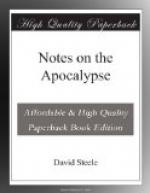With these preliminaries, and expressing my obligation to the Doctor’s labors, to whose system of interpretation as well as to most of his details, I cheerfully give my approbation in preference to all other expositors whose works it has been in my power to consult; it is proposed briefly to review some of his expositions and sentiments, from which I crave liberty to dissent. “It is not the interest of any man to be in error.”
In his interpretation of the seals and trumpets of the Apocalypse, Dr. M’Leod has unquestionably corrected many misapprehensions of his learned predecessors, especially Bishop Newton and Mr. Faber: and it is perhaps to be regretted that he did not favor the public with his view of the vials also, a work which he seems to have had in contemplation when the “Lectures” were published. The three last named interpreters did certainly improve upon the expositions of all who went before them in this field of investigation; and in most cases of disagreement the Doctor excelled in accuracy the other two, as will readily appear on careful examination.
In attempting to ascertain the import of the mystic “witnesses,” as of the Antichrist, expositors widely differ. Bishop Newton says positively,—“The witnesses cannot be ... any two churches.” Mr. Faber is equally peremptory, that they “must be two churches,” and he attempts to sustain his position by many citations of Scripture, and by much plausible argumentation. The Bishop is substantially correct in saying, “They are a succession of men, and a succession of churches.” Mr. Faber is also correct in the main when he says,—“The two witnesses signify the spiritual members of the catholic church:” but his notion of two churches, the “Old and New Testament churches,” betrays his imperfect conception of the essential unity of the church of God. Both he and the Bishop overlook too often the important fact that civil magistracy is a divine ordinance, which, as corrupted, constitutes the first beast of the Apocalypse, and the most prominent feature of the great Antichrist.




